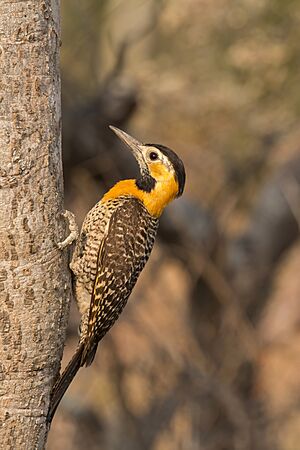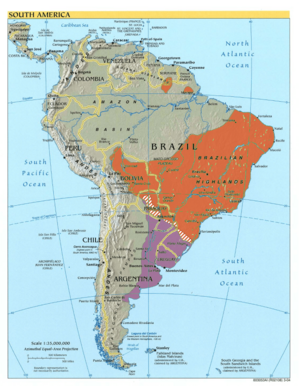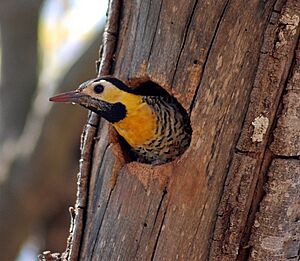Campo flicker facts for kids
The campo flicker (Colaptes campestris) is a type of bird that belongs to the woodpecker family. It lives in several countries in South America, including Argentina, Bolivia, Brazil, Paraguay, Suriname, and Uruguay.
Quick facts for kids Campo flicker |
|
|---|---|
 |
|
| Female C. c. campestris, the Pantanal, Brazil | |
| Conservation status | |
| Scientific classification | |
| Genus: |
Colaptes
|
| Species: |
campestris
|
| Subspecies | |
|
|
|
 |
|
| Distribution of C. c. campestris (orange) and C. c. campestroides (purple) | |
Contents
What is a Campo Flicker?
The campo flicker was first described as Picus campestris. Scientists group animals to understand them better. This bird is part of the woodpecker family.
Different Types of Campo Flickers
There are two main types, or subspecies, of the campo flicker. They are called C. c. campestris and C. c. campestroides. Some scientists think these two types might actually be separate species. One is sometimes called the "field flicker" or "pampas flicker".
What Does the Campo Flicker Look Like?
The campo flicker is about 30 centimeters (12 inches) long. It weighs around 150 grams (5.3 ounces). Males and females look very similar. The main difference is on their faces. Males have a red stripe on their cheek area. Females have a black stripe there instead.
Both types of campo flickers have a black top of the head. Their faces are yellow with white around their eyes. The campestris type has a black throat. The campestroides type has a white throat. This is the only major difference between them.
Their upper body is brown with dull white stripes. Their lower back is white with a few dark stripes. Their wing feathers are brown with yellow shafts. The top of their tail is black. The outer tail feathers have thin lighter stripes. Their belly is white with brown stripes. They have a gray bill, reddish-brown eyes, and gray legs. Young campo flickers look much like adults but have lighter yellow feathers.
Where Do Campo Flickers Live?
The campo flicker lives in different areas across South America. The campestris type is found in southern Suriname and northern Brazil. It also lives in a much larger area from eastern Brazil down to central Paraguay and northern Bolivia.
The C. c. campestroides type lives in central and southern Paraguay. It is also found in southern Brazil, Uruguay, and northeastern Argentina. These two types sometimes breed together where their territories meet. This happens in Paraguay and southern Brazil.
Campo Flicker Homes
Campo flickers live in many different kinds of places. They prefer open or partly open areas. These include grassy plains like savannas and the Pampas. They also live in scrublands and along the edges of forests. You can find them in grasslands, open woodlands, and even places changed by people. These include parks, farms, and pastures. They can live from low areas (about 80 meters or 260 feet) up to high places (about 1700 meters or 5,600 feet).
How Do Campo Flickers Behave?
Staying in One Place
Campo flickers usually stay in the same area all year round. They do not migrate to different places.
What Do Campo Flickers Eat?
These birds mostly find their food on the ground. They often feed in pairs or small groups. Sometimes, up to seven birds can be seen eating together. They peck, dig, and search for food. They look in ant and termite mounds, in the soil, among rocks, and in dead wood. Their main food is ants and termites, including their young. They also eat a very small amount of fruit.
How Do Campo Flickers Raise Their Young?
The breeding season for campo flickers is not fully known. However, in Argentina and central Brazil, it is busiest in August and September. Both the male and female help dig a nest hole. They make these nests in termite mounds, dirt banks, trees, or fence posts.
Campo flickers are mostly monogamous, meaning one male and one female pair up. However, sometimes other females might lay eggs in the nest. They usually lay four or five eggs. Scientists are still learning about how long the eggs take to hatch and how long the young birds stay in the nest.
What Sounds Do Campo Flickers Make?
Campo flickers make many different sounds. Their song is a fast "wicwicwic---" sound, repeated many times. Their calls are often high, sharp, and sound a bit like a nose being blown. They make sounds like "tih", "tir", or "wur". When a pair of flickers calls together, it sounds like a high "wicwicwic" answered right away by a low "wucwucwuc".
Is the Campo Flicker Endangered?
The campo flicker is considered a species of "Least Concern" by conservation groups. This means it is not currently at risk of disappearing. Both types of campo flickers have large areas where they live. Their populations are thought to be growing. There are no immediate threats to them. The bird is common throughout its range. While more open areas created by humans might help them, they could also lose nesting spots if too many trees are cut down.



